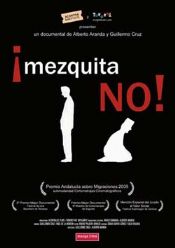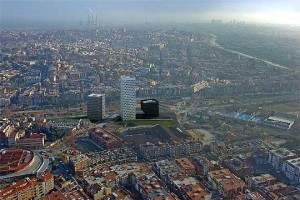
Six cities around Barcelona – Hospitalet, Badalona, Terrassa, Sabadell, Mataró, Santa Coloma de Gramenet – are among the ten most populated in Catalonia. But only Hospitalet and Santa Coloma have a higher density than Barcelona, compact city par excellence. The urbanistic chaos that characterises Santa Coloma de Gramanet is the direct result of real estate speculation and political corruption: persistent racism among some sectors of its population is the other side of overcrowding and impressive diversity of origins that defines the people of Santako. But if in the beginning of the 20th century, those who rejected the immigrants from southern Spain settled in the casas baratas at least could hold to their local origins and catalan speech, in the 21th century those who promote boycott to arabics, chinese, latinamericans, romans of the city, are themselves – for the most part – second generation immigrants. The video Mézquita no! (2005) describes the conflict around the opening of a mosque in the Singuerlin neighborhood.

In the last local elections, the xenofobic party Plataforma per Catalunya achieved 3 councilors, none of them living in Santa Coloma, through a campaign based only on racism; joining the wave of extreme right parties now rising in all Europe, and catching the votes of workers disappointed for the corruption and cinism of left-wing parties. The socialist mayor arrested for corruption in 2009, Bartomeu Muñoz, also lived in a rich neighborhood of Barcelona, far from the conflicts and overcrowding in which lived “his” citizens.
- Alberto ARANDA, Guillermo CRUZ (2005) “¡Mezquita NO!“, documentary about the conflict in Santa Coloma de Gramenet: “This documentary is made at ground level, close to the streets, you can almost feel the smell of the asphalt and of the people. A social document developed with a dynamic, fresh and lively language” [LINK TO THE VIDEO on WebIslam]
- Centre d’Acolliment de Santa Coloma since 1993 has been fighting against racism and to help immigrants who arrived recently to the city: getting involved in social conflicts, and offering them free spanish classes (though most of its activists are catalan-speaking; but they had to adapt to the lack of spanish courses offered by the public administrations!)
- Debate in 2004 about racism, mass media and “garrulos” on Indymedia Barcelona [LINK]
- Chinese immigration in Fondo neighborhood (part of Santa Coloma) in 10 years reached to be the 11% of the population. It has been studied by Joaquín BELTRÁN and Xavier BENVENUTY.
- Santa Coloma de Gramenet – Gramenet del Besós during the Republic (1931-1939) – has also a big antiracist and libertarian tradition: take a look at ARA (Actuar- Reflexionar-Aprendre) Santacoloma [from its webpage you can reach many groups of the city]
- The Grupo de Historia José Berruezo, directed by Juan José GALLARDO ROMERO, has been collecting the history of anarchism and workers movement in Santa Coloma since various decades [see the webpage of Agora magazine].
- Ateneu Popular Julia Romera is a meeting point for various groups of activists in Santako [its webpage]
- Biblioteca Social La Hoguera, located inside the Ateneu, has a collection of various thousands of titles on present and past struggles, locals as well as globals [its webpages (1)-(2) aren’t very active yet]